Fractographic Study on Naturally Initiated Short Fatigue Cracks in a Near-Lamellar TiAl Alloy at Room Temperature
Abstract
:1. Introduction
2. Material and Experimental Methods
2.1. Material and Specimen
2.2. Testing Methods
3. Results
3.1. Fatigue Failures under Defect-Free Condition
3.2. Naturally Initiated Fatigue Cracks
- surrounded by radial patterns (such as steps, striations)
- flatter fracture surface compared to final fracture region
- crack growth direction perpendicular to main principal stress
- cracks grow transgranularly
4. Discussions
4.1. Naturally Initiated Short Fatigue Cracks
4.2. Evaluations of Fatigue Crack Initiation
4.3. Effect of Stress Ratio on Naturally Initiated Fatigue Cracks
4.4. Short Fatigue Crack in Lamellar γ-TiAl Alloys
5. Conclusions
- At a low stress ratio (R = 0.1), the short fatigue cracks are likely to initiate either from three to four conjoined interlamellar fractures at or near mode-I direction or stress concentration areas, e.g., machining surface damage. These mode-I cracks can grow translamellarly to become long cracks and lead to the final failure. Specimens failed at lower ultimate maximum fatigue stresses compared to the tests carried out at R = 0.5.
- At a high stress ratio (R = 0.5), microcracks still tend to firstly nucleate at colonies at or near mode-I orientation, but as a consequence of increased shear stress, interlamellar fractures can be formed at higher angles due to shear deformation. Unlike the circumstance at R = 0.1, the critical crack length is reached by coalescence of the interlamellar fractures at various angles, which is achieved primarily via colony boundary cracking and a small portion of translamellar fractures. The fatigue crack initiation sites are relatively tortuous and multifaceted compared to the R = 0.1 tests.
Author Contributions
Funding
Acknowledgments
Conflicts of Interest
References
- Lee, H.J.; Strahan, N.; Boyd, E. Turbocharger Jet Engine Build. and Engineering Analysis; Mechanical Engineering and Materials Science Independent Study at Washington University: St. Louis, MO, USA, 2016. [Google Scholar]
- Jha, S.K.; Larsen, J.M.; Rosenberger, A.H. The role of competing mechanisms in the fatigue life variability of a nearly fully-lamellar γ-TiAl based alloy. Acta Mater. 2005, 53, 1293–1304. [Google Scholar] [CrossRef]
- Chan, K.S. Toughening mechanisms in titanium aluminides. Metall. Trans. A 1993, 24, 569–583. [Google Scholar] [CrossRef]
- Campbell, J.P.; Venkateswara Rao, K.T.; Ritchie, R.O. On the role of microstructure in fatigue-crack growth of γ-based titanium aluminides. Mater. Sci. Eng. A 1997, 239–240, 722–728. [Google Scholar] [CrossRef]
- Appel, F.; Wagner, R. Microstructure and deformation of two-phase γ-titanium aluminides. Mater. Sci. Eng. R Rep. 1998, 22, 187–268. [Google Scholar] [CrossRef]
- Wessel, W.; Zeismann, F.; Brueckner-Foit, A. Short fatigue cracks in intermetallic γ-TiAl-alloys. Fatigue Fract. Eng. Mater. Struct. 2016, 38, 1507–1518. [Google Scholar] [CrossRef]
- Kruzic, J.J.; Campbell, J.P.; Ritchie, R.O. On the fatigue behavior of gamma-based titanium aluminides: Role of small cracks. Acta Mater. 1999, 47, 801–816. [Google Scholar] [CrossRef]
- Pippan, R.; Hageneder, P.; Knabl, W.; Clemens, H.; Hebesberger, T.; Tabernig, B. Fatigue threshold and crack propagation in gamma-TiAl sheets. Intermetallics 2001, 9, 89–96. [Google Scholar] [CrossRef]
- Schijve, J. Fatigue of Structures and Materials; Springer Science & Business Media: Berlin, Germany, 2001. [Google Scholar]
- Gnanamoorthy, R.; Mutoh, Y.; Mizuhara, Y. Fatigue crack growth behavior of equiaxed, duplex and lamellar microstructure γ-base titanium aluminides. Intermetallics 1996, 4, 525–532. [Google Scholar] [CrossRef]
- Kim, Y.-W. Effects of microstructure on the deformation and fracture of γ-TiAl alloys. Mater. Sci. Eng. A 1995, 192–193, 519–533. [Google Scholar] [CrossRef]
- Gnanamoorthy, R.; Mutoh, Y.; Hayashi, K.; Mizuhara, Y. Influence of lamellar lath orientation on the fatigue crack growth behavior of gamma base titanium aluminides. Scr. Metall. Mater. 1995, 33, 907–912. [Google Scholar] [CrossRef]
- Yang, J.; Li, H.; Hu, D.; Martin, N.; Dixon, M. Lamellar orientation effect on fatigue crack propagation threshold in coarse grained Ti46Al8Nb. Mater. Sci. Technol. 2014, 30, 1905–1910. [Google Scholar] [CrossRef]
- Wang, Y.; Yuan, H.; Ding, H.; Chen, R.; Guo, J.; Fu, H.; Li, W. Effects of lamellar orientation on the fracture toughness of TiAl PST crystals. Mater. Sci. Eng. A 2019, 752, 199–205. [Google Scholar] [CrossRef]
- Huang, Z.W.; Bowen, P.; Jones, I.P. Transmission electron microscopy investigation of fatigue crack tip plastic zones in a polycrystalline γ-TiAl-based alloy. Philos. Mag. A 2001, 81, 2183–2197. [Google Scholar] [CrossRef]
- Appel, F.; Paul, J.D.H.; Oehring, M. Gamma Titanium Aluminide Alloys: Science and Technology; Wiley: Hoboken, NJ, USA, 2011. [Google Scholar]
- Chen, M.; Lin, D.; Da, C. Influence of lamellar lath orientation on crack propagation in a gamma TiAl alloy. Acta Met. Sin. 1994, 36, 497–501. [Google Scholar] [CrossRef]
- Chan, K.S.; Wang, P.; Bhate, N.; Kumar, K.S. Intrinsic and extrinsic fracture resistance in lamellar TiAl alloys. Acta Mater. 2004, 52, 4601–4614. [Google Scholar] [CrossRef]
- Levan, A.; Royer, J. Part-circular surface cracks in round bars under tension, bending and twisting. Int. J. Fract. 1993, 61, 71–99. [Google Scholar] [CrossRef]
- Zhu, S.J.; Peng, L.M.; Moriya, T.; Mutoh, Y. Effect of stress ratio on fatigue crack growth in TiAl intermetallics at room and elevated temperatures. Mater. Sci. Eng. A 2000, 290, 198–206. [Google Scholar] [CrossRef]
- Schijve, J. Stress Intensity Factors of Cracks. In Fatigue of Structures and Materials; Springer: Berlin, Germany, 2009; pp. 105–140. [Google Scholar]
- Sadananda, K.; Vasudevan, A. Fatigue crack growth behaviour in titanium aluminides. Mater. Sci. Eng. A 1995, 192, 490–501. [Google Scholar] [CrossRef]
- Ritchie, R.O. Mechanisms of fatigue crack propagation in metals, ceramics and composites: Role of crack tip shielding. Mater. Sci. Eng. A 1988, 103, 15–28. [Google Scholar] [CrossRef]
- Ritchie, R.O. Mechanisms of fatigue-crack propagation in ductile and brittle solids. Int. J. Fract. 1999, 100, 55–83. [Google Scholar] [CrossRef]
- Hénaff, G.; Gloanec, A.-L. Fatigue properties of TiAl alloys. Intermetallics 2005, 13, 543–558. [Google Scholar] [CrossRef]
- Campbell, J.P.; Kruzic, J.J.; Lillibridge, S.; Venkateswara Rao, K.T.; Ritchie, R.O. On the growth of small fatigue cracks in γ-based titanium aluminides. Scr. Mater. 1997, 37, 707–712. [Google Scholar] [CrossRef]
- Henaff, G.; Cohen, S.A.; Mabru, C.; Petit, J. The role of crack closure in fatigue crack propagation behaviour of a TiAl-based alloy. Scr. Mater. 1996, 34, 1449–1454. [Google Scholar] [CrossRef]
- El Haddad, M.H.; Smith, K.N.; Topper, T.H. Fatigue Crack Propagation of Short Cracks. J. Eng. Mater. Technol. 1979, 101, 42–46. [Google Scholar] [CrossRef]
- Taylor, D.; Knott, J. Fatigue crack propagation behaviour of short cracks; the effect of microstructure. Fatigue Fract. Eng. Mater. Struct. 1981, 4, 147–155. [Google Scholar] [CrossRef]
- Ritchie, R.; Peters, J. Small fatigue cracks: mechanics, mechanisms and engineering applications. Mater. Trans. 2001, 42, 58–67. [Google Scholar] [CrossRef]
- Patnaik, S.N.; Hopkins, D.A. Chapter 2–Determinate Truss. In Strength of Materials: A New Unified Theory for the 21st Century; Elsevier: Amsterdam, The Netherlands, 2004; pp. 55–128. [Google Scholar]
- Sadananda, K.; Vasudevan, A.K. Multiple mechanisms controlling fatigue crack growth. Fatigue Fract. Eng. Mater. Struct. 2003, 26, 835–845. [Google Scholar] [CrossRef]
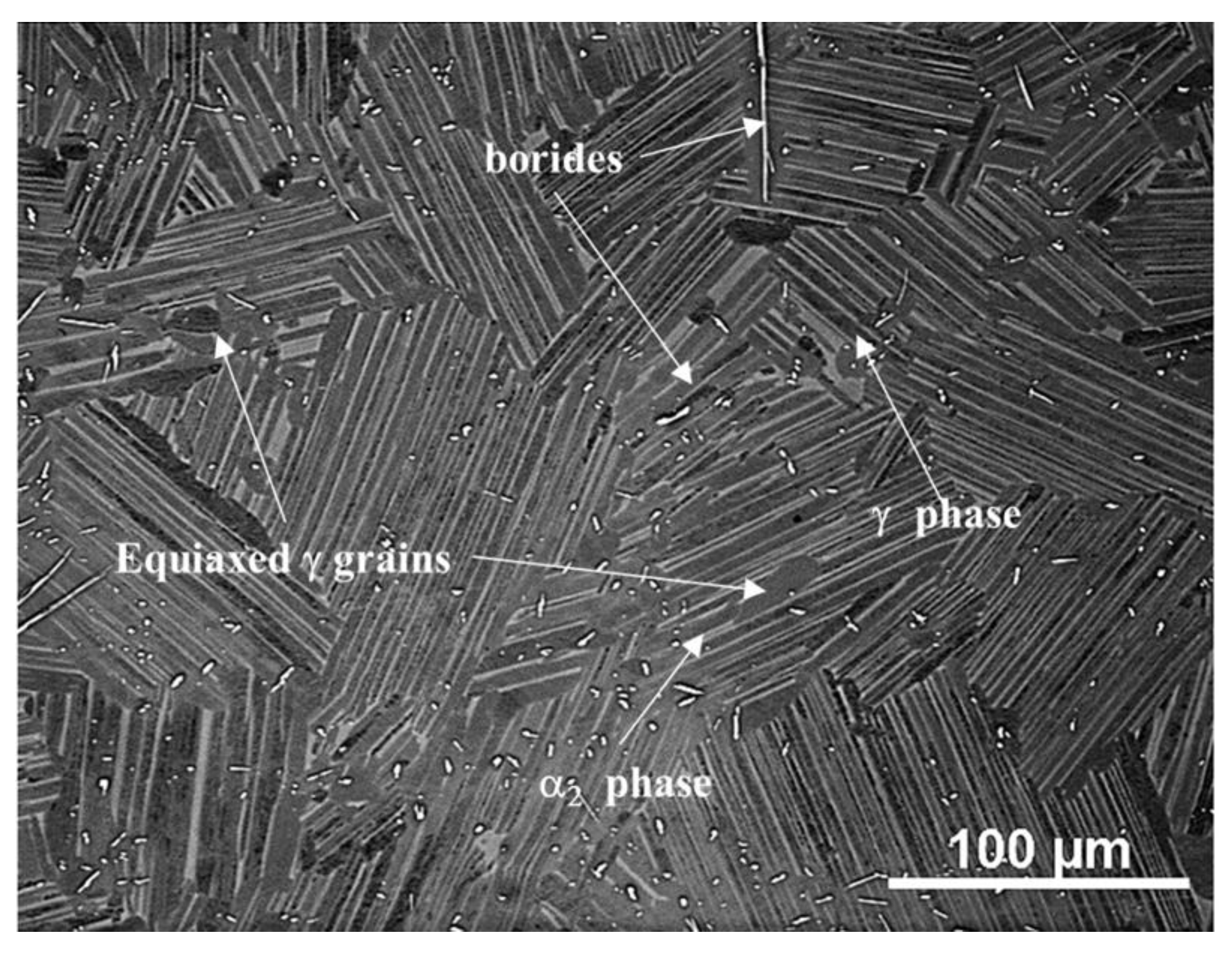
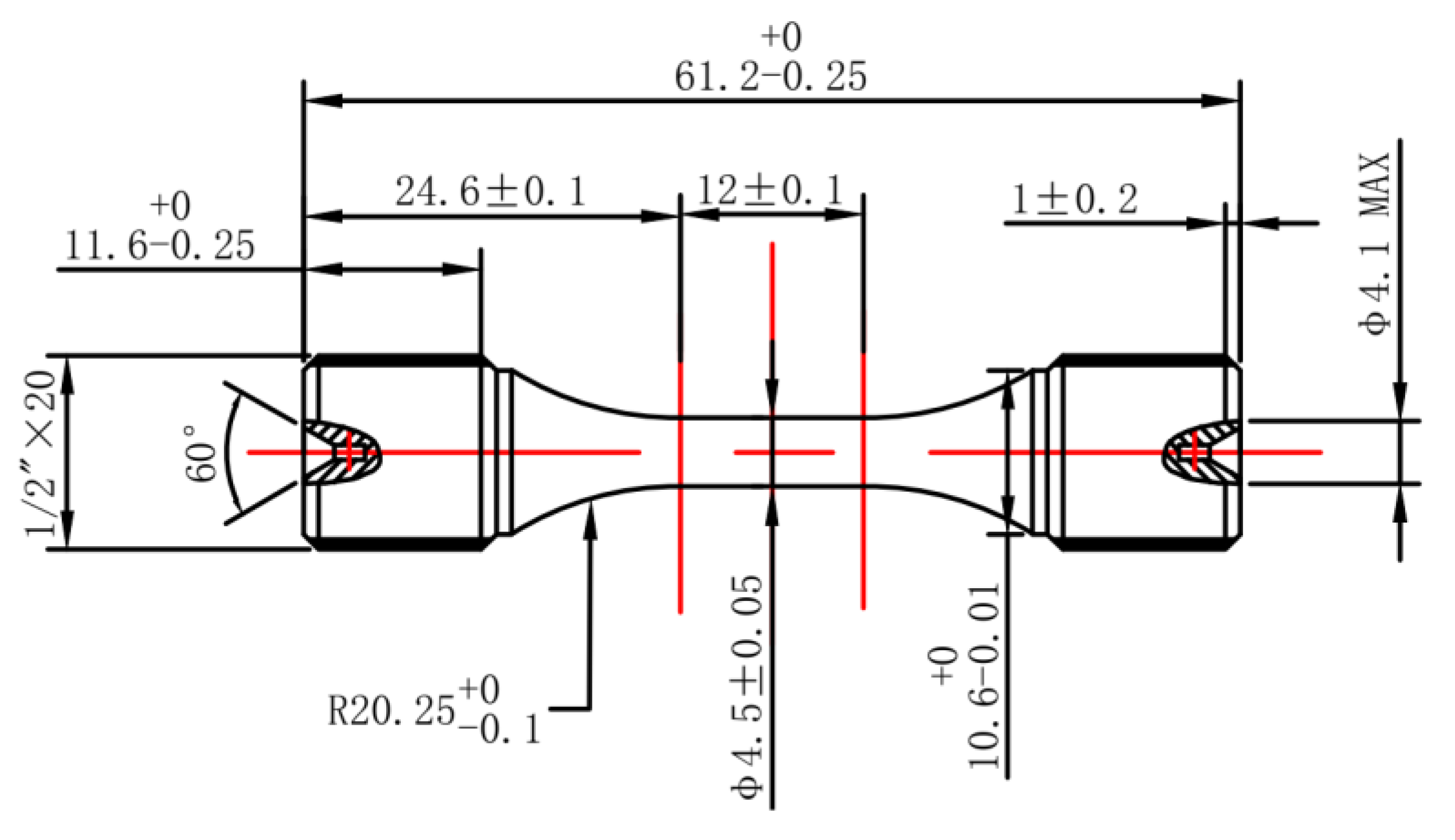
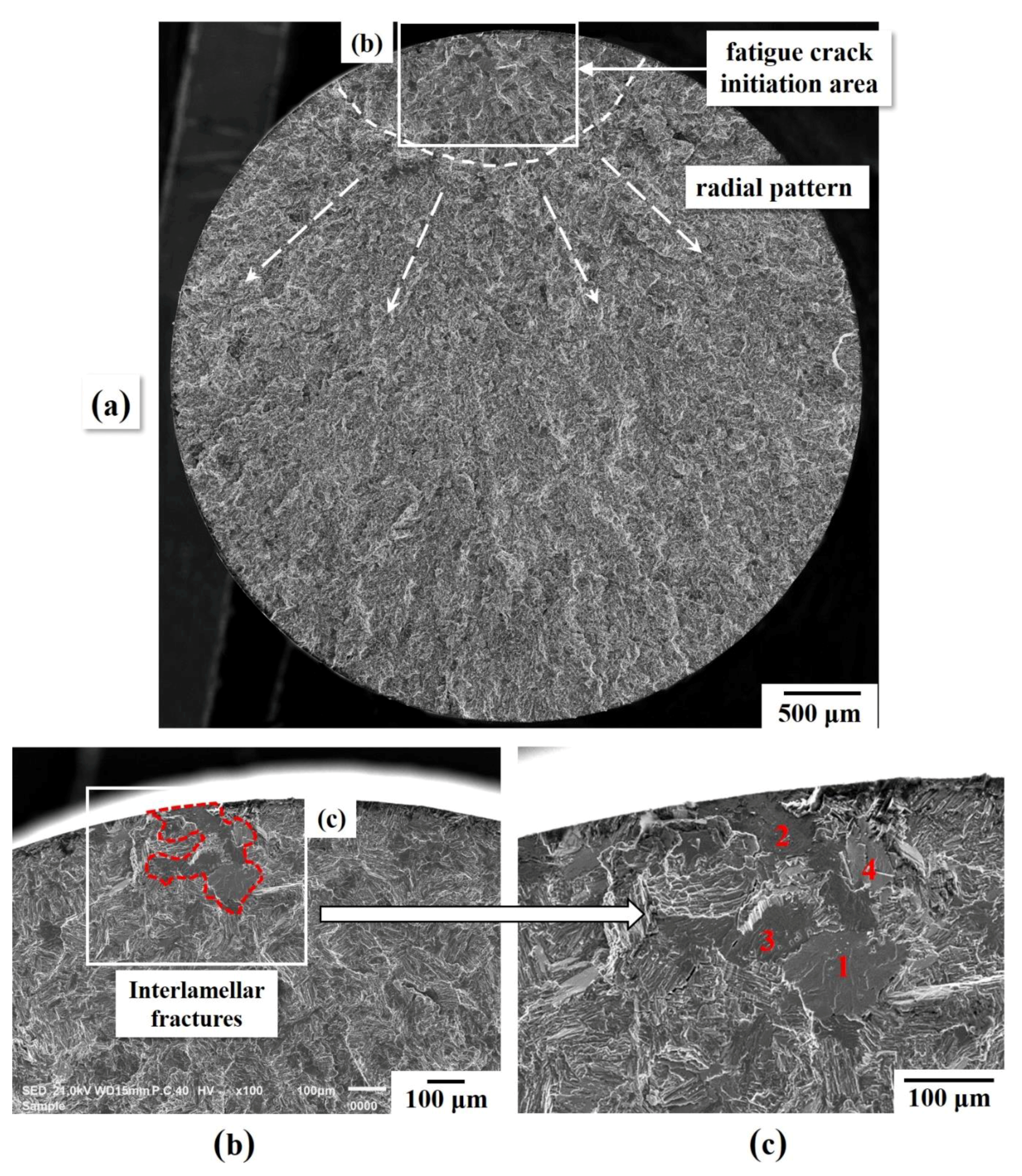
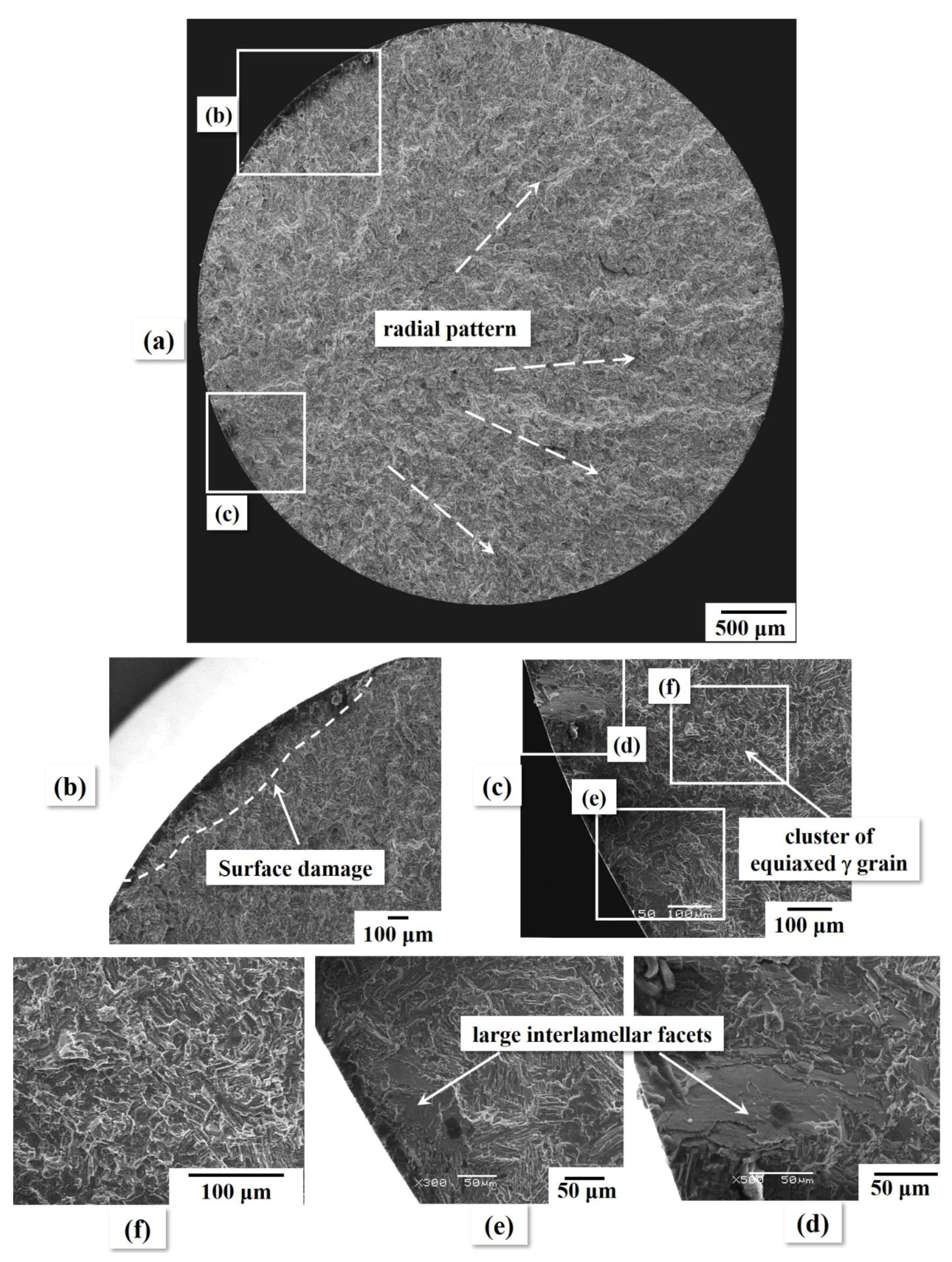
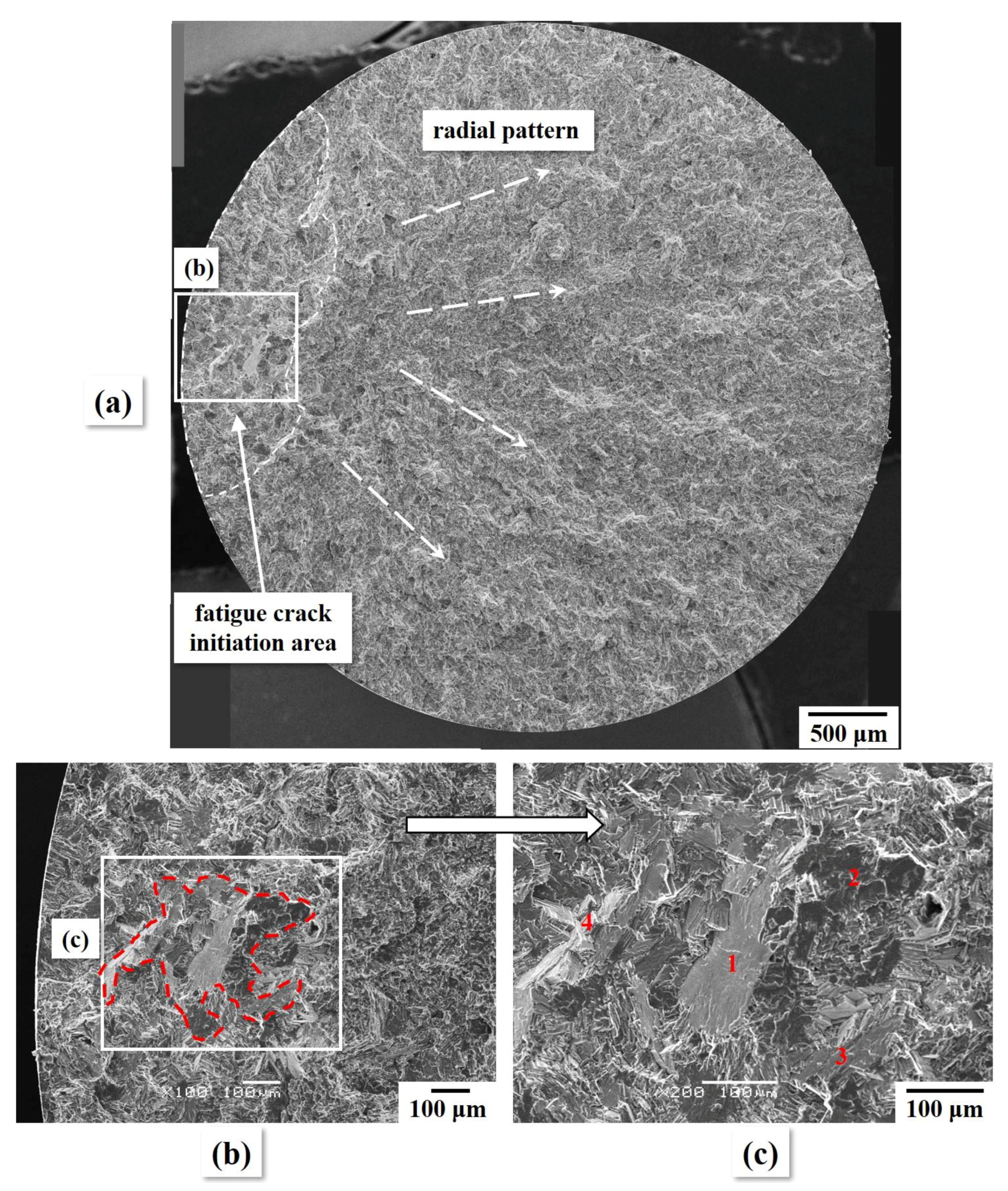
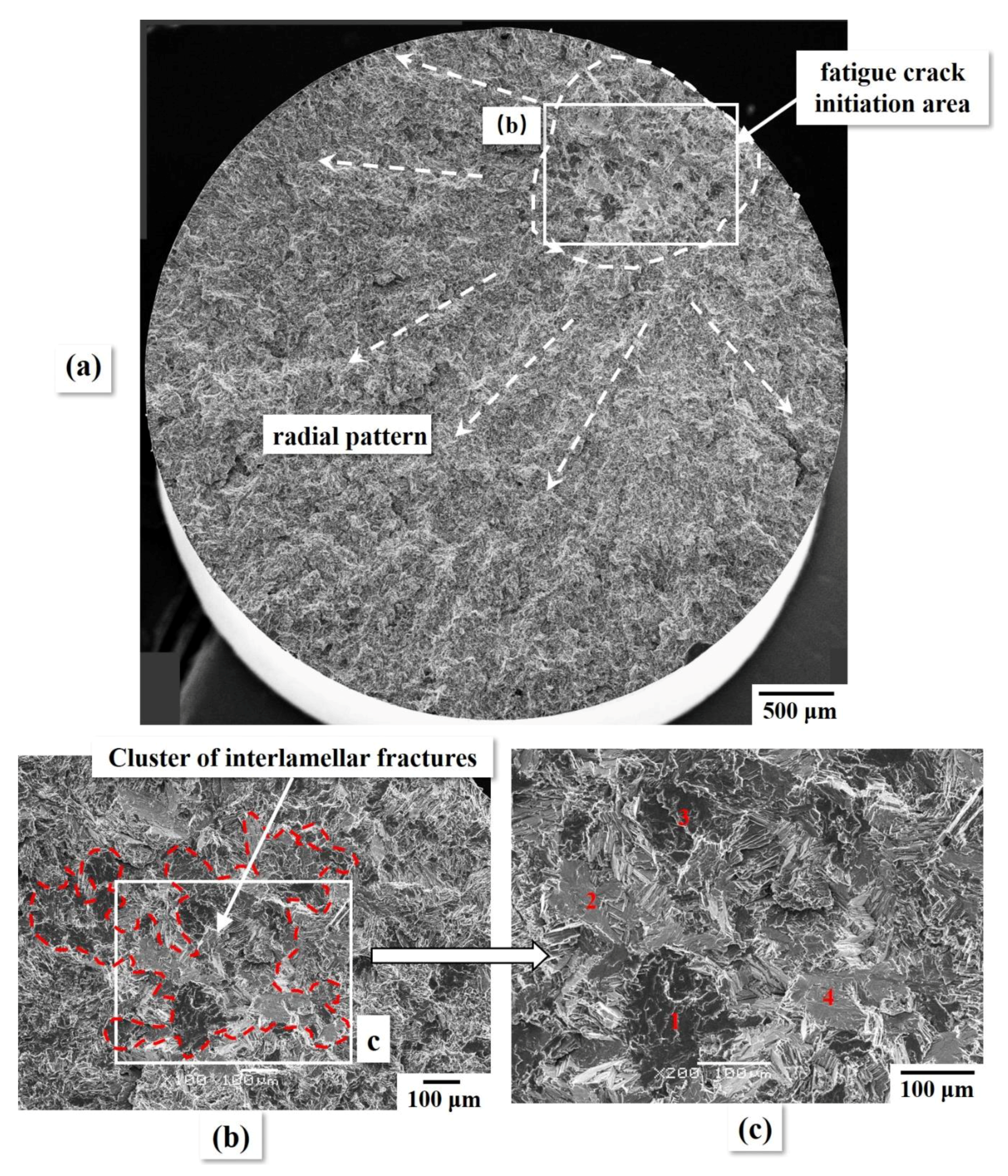
| Specimen ID | Stress Ratio (R) | σmax/MPa | σmin/MPa | Δσ/MPa | Total Cycle |
|---|---|---|---|---|---|
| RC1 | 0.1 | 425 | 42.5 | 382.5 | 6.6 × 106 |
| RC2 | 0.1 | 475 | 47.5 | 427.5 | 3.7 × 106 |
| RC3 | 0.5 | 570 | 285 | 285 | 2.6 × 106 |
| RC4 | 0.5 | 560 | 280 | 280 | 8.4 × 106 |
| Specimen ID | Crack Type | a (μm) | K Solution | ΔK (MPa·m1/2) | Κmax (MPa·m1/2) |
|---|---|---|---|---|---|
| RC1 | surface breaking semi-circular crack | 178 | [19] | 6.4 | 7.1 |
| RC2 | multi surface breaking crack | N/A | N/A | N/A | N/A |
| RC3 | embedded penny-shaped crack | 242 | [21] | 5.0 | 10.0 |
| RC4 | embedded penny-shaped crack | 280 | [21] | 5.3 | 10.6 |
| Crack Type | R Ratio | σmax (MPa) | 2a (μm) | ΔK (MPa·m1/2) | Average ΔK (MPa·m1/2) | Kmax (MPa·m1/2) |
|---|---|---|---|---|---|---|
| embedded penny-shaped microcrack | 0.1 | 450 | 40–130 (80 for average) | 2.1–3.7 | 3.2 | 2.3–4.1 |
| 0.5 | 565 | 1.4–2.6 | 2.0 | 2.8–5.2 |
© 2019 by the authors. Licensee MDPI, Basel, Switzerland. This article is an open access article distributed under the terms and conditions of the Creative Commons Attribution (CC BY) license (http://creativecommons.org/licenses/by/4.0/).
Share and Cite
Wang, S.; Xi, Y.; Li, H.; Bowen, P. Fractographic Study on Naturally Initiated Short Fatigue Cracks in a Near-Lamellar TiAl Alloy at Room Temperature. Metals 2019, 9, 1101. https://doi.org/10.3390/met9101101
Wang S, Xi Y, Li H, Bowen P. Fractographic Study on Naturally Initiated Short Fatigue Cracks in a Near-Lamellar TiAl Alloy at Room Temperature. Metals. 2019; 9(10):1101. https://doi.org/10.3390/met9101101
Chicago/Turabian StyleWang, Shiyuan, Yingzi Xi, Hangyue Li, and Paul Bowen. 2019. "Fractographic Study on Naturally Initiated Short Fatigue Cracks in a Near-Lamellar TiAl Alloy at Room Temperature" Metals 9, no. 10: 1101. https://doi.org/10.3390/met9101101
APA StyleWang, S., Xi, Y., Li, H., & Bowen, P. (2019). Fractographic Study on Naturally Initiated Short Fatigue Cracks in a Near-Lamellar TiAl Alloy at Room Temperature. Metals, 9(10), 1101. https://doi.org/10.3390/met9101101




